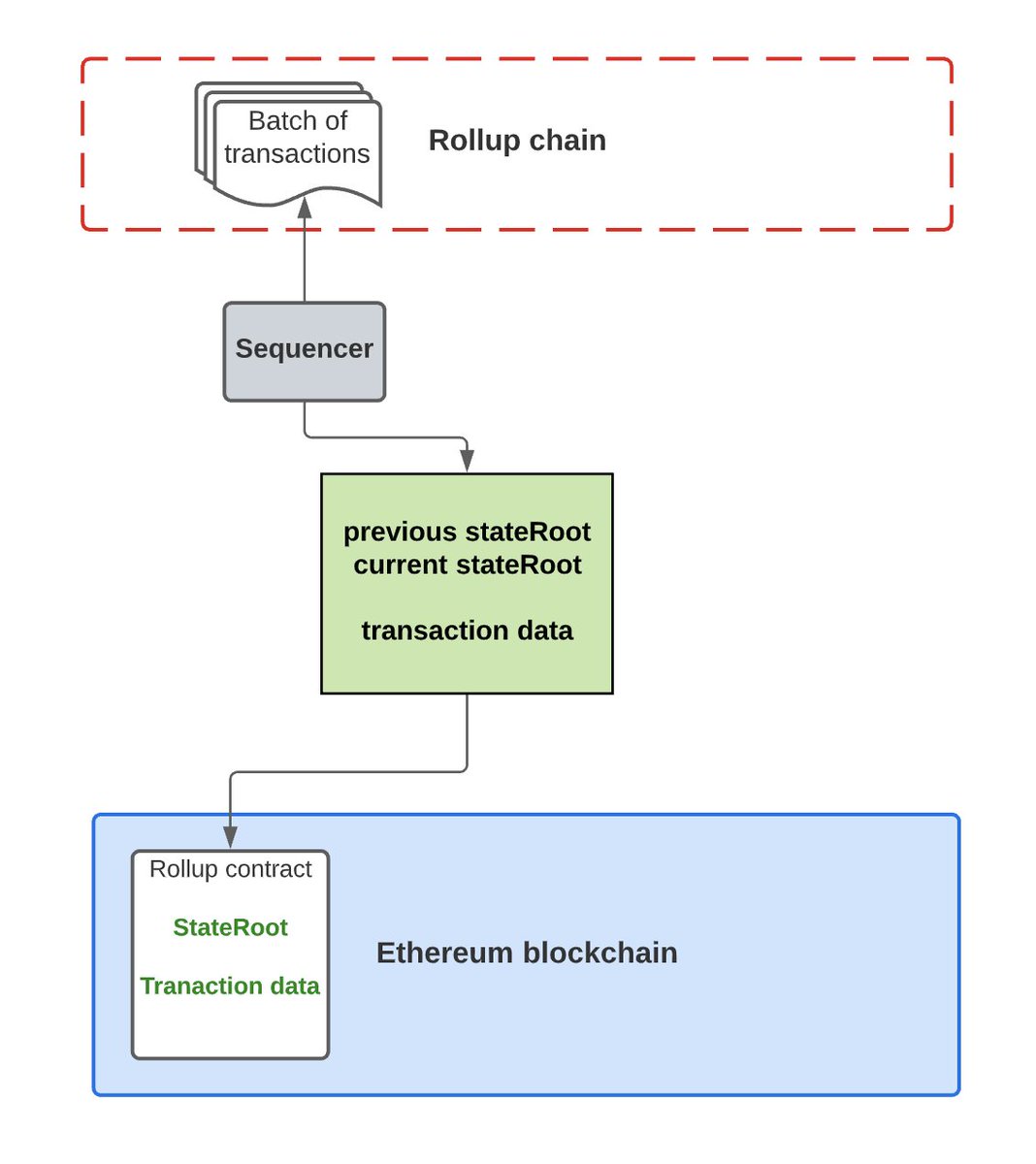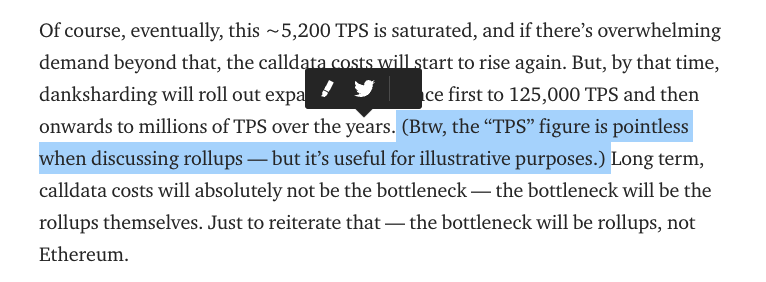
1/ 🧵
#danksharding, #PBS, #crList, #blob transactions...
Seems #Ethereum has an affinity for making up words these days! And it all starts with (the normal sounding) #calldata
Let's figure out why, define some of these ridiculous terms, and see how #ETH can get even better
#danksharding, #PBS, #crList, #blob transactions...
Seems #Ethereum has an affinity for making up words these days! And it all starts with (the normal sounding) #calldata
Let's figure out why, define some of these ridiculous terms, and see how #ETH can get even better
2/ #Rollups (RU) post their compressed L2 batched transactions as calldata onto mainnet Ethereum. But what does that mean and what is calldata?
#l222
Calldata (CD) is a specific form of read-only memory data used by smart contracts to call external functions.
#l222
Calldata (CD) is a specific form of read-only memory data used by smart contracts to call external functions.

Once a RU has batched enough txs, it posts this state transition change in a compressed form to the L1 via CD.
RUs currently utilize L1 CD for data storage, which is limited to ~10KB per block. This is so anyone has the ability to reconstruct the chain & verify the latest state
RUs currently utilize L1 CD for data storage, which is limited to ~10KB per block. This is so anyone has the ability to reconstruct the chain & verify the latest state

Posting the CD onchain is what allows #ETH & its network of nodes to “check the work” done off-chain. Instead of doing the computation, the CD enables the mainnet to easily verify that everything done off-chain was valid and accept the state changes i.e. double-check the work.
5/ Additionally, the availability of data on the ETH L1 means that any computation completed on a rollup can be redone by the Ethereum base layer, if needed. Without sufficient data availability, transaction execution becomes opaque/ a black box that cannot be audited by the L1.
6/ This ability to reconstruct the chain is critical. It provides security guarantees for the users (don’t have to trust the Sequencer, check for yourself!) and removes catastrophic risk due to Sequencer issues.
@iam_preethi @phtevenstrong
@iam_preethi @phtevenstrong

If a Sequencer suddenly disappeared, a new Sequencer could retrieve all the L2 data from L1, reconstruct the latest RU state, & continue on.
Txs are compressed to only the necessary components (the to/from addresses, transaction value, network fee, and nonce) for reconstruction.
Txs are compressed to only the necessary components (the to/from addresses, transaction value, network fee, and nonce) for reconstruction.
8/ Currently, the cost of posting calldata to L1 Ethereum is 16 gas/byte.
#EIP-4488 proposed lowering the cost of calldata to 3 gas per byte, while EIP-4844 is a separate proposal to create a new data format specifically designed to lower the cost for RUs of posting data on L1.
#EIP-4488 proposed lowering the cost of calldata to 3 gas per byte, while EIP-4844 is a separate proposal to create a new data format specifically designed to lower the cost for RUs of posting data on L1.
9/ So we've covered what calldata is, how rollups use it, and what it costs.
But now we're getting to the good stuff. Why is everyone is #Ethereum world trying to replace it with fantastical-sounding ideas??
@VitalikButerin @pseudotheos
But now we're getting to the good stuff. Why is everyone is #Ethereum world trying to replace it with fantastical-sounding ideas??
@VitalikButerin @pseudotheos
10/ Current implementations of rollups use calldata. However, the #EVM is not optimized to process rollup data in a cost-efficient manner. This is because rollups were not even an idea when the EVM was built!
@0xGreg_ @j0hnwang
@0xGreg_ @j0hnwang
11/ Regardless, the EVM assumes data in a transaction will be processed by a smart contract and charges for it accordingly (more expensive).
Unfortunately, this approach does not do rollups any favors.
@odin_free @Swagtimus
Unfortunately, this approach does not do rollups any favors.
@odin_free @Swagtimus
12/ In the future, RUs will evolve to using sharded data (also called “blobs”) because sharded data will be much cheaper.
The newly proposed EIP-4488 is simple. It would just reduce the cost of posting this calldata onto the mainnet. Savings!
@epolynya @yahgwai
The newly proposed EIP-4488 is simple. It would just reduce the cost of posting this calldata onto the mainnet. Savings!
@epolynya @yahgwai
EIP-4844 is a far bigger change.
It is a proposal for a temporary solution until a more permanent solution entitled “#danksharding” is fully ready to be implemented.
EIP-4844 introduces “blob-carrying” transactions as a means of storage for rollups.
@asn_d6 @protolambda
It is a proposal for a temporary solution until a more permanent solution entitled “#danksharding” is fully ready to be implemented.
EIP-4844 introduces “blob-carrying” transactions as a means of storage for rollups.
@asn_d6 @protolambda
14/ It is an entirely new transaction format and only the blob’s hash can be accessed via a new opcode. This guarantees the data content will never be accessed by the EVM reduces the gas cost of posting the data compared to with calldata.
@FairyproofT @masonic_tweets
@FairyproofT @masonic_tweets

15/ #Blobtransactions can enable up to ~1MB average per block for data storage (vs ~10KB currently with calldata) & it has been proposed that they could be pruned (removed) after a period to reduce storage overhead requirements.
Blob txs are compatible with all rollups types.
Blob txs are compatible with all rollups types.
16/ Danksharding, from ETH core developer @dankrad, is a long-term solution for optimizing RUs with a sharded architecture.
Danksharding is designed to optimize #MEV by introducing two new roles into the Ethereum ecosystem: builder and proposer
@Darrenlautf @BillyBobBaghold
Danksharding is designed to optimize #MEV by introducing two new roles into the Ethereum ecosystem: builder and proposer
@Darrenlautf @BillyBobBaghold
As discussed previously, a block proposer (or miner) in a traditional blockchain (like Ethereum currently) can choose which transactions to include from the memepool into the next block based on the highest transaction fees.
@antiprosynth
@antiprosynth
18/ Danksharding looks to fix this by dividing the block proposer role into builders & proposers.
Builders don't get to choose which txs to include, rather, it is fed a list of txs from the proposers in the form of a special list called a crList.
@jadler0 @sassal0x
Builders don't get to choose which txs to include, rather, it is fed a list of txs from the proposers in the form of a special list called a crList.
@jadler0 @sassal0x
19/ “crList” forces the builders to include certain transactions, eliminating their potential to censor transactions. By forcing builders to be honest, the protocol stays trustless.
@HaymanLiron @BenGiove @plebonacci
@HaymanLiron @BenGiove @plebonacci
While crList specifies which txs the builder is forced to include, it doesn't specify the order of the txs.
Builders can then reorder the txs within the crList to maximize their MEV. This essentially optimizes MEV benefits for miners, while precluding builders from censoring txs
Builders can then reorder the txs within the crList to maximize their MEV. This essentially optimizes MEV benefits for miners, while precluding builders from censoring txs
21/ Danksharding results in execution blocks and shard blocks being built together. This means there will be no delays in shard blocks confirmation and all data will be immediately available to L1.
(this is coming from @dankrad and I'm still wrapping my head around) @litocoen
(this is coming from @dankrad and I'm still wrapping my head around) @litocoen

The big payoff for all this?
Because there are no separate shards specifically for txs, the L1 mainnet can serve as both a settlement and data availability layer, reducing complexity in the system.
This has been estimated to improve L1 throughput ~6400x.
Because there are no separate shards specifically for txs, the L1 mainnet can serve as both a settlement and data availability layer, reducing complexity in the system.
This has been estimated to improve L1 throughput ~6400x.
23/ So, there ya go.
A lot of computer wizardry and sci-fi language to basically say rollups and calldata are breaking up but everyone will be better off for it.
$ETH gets used more efficiently and rollups maximize their potential while reducing costs.
A lot of computer wizardry and sci-fi language to basically say rollups and calldata are breaking up but everyone will be better off for it.
$ETH gets used more efficiently and rollups maximize their potential while reducing costs.
24/ As with everything in #Ethereum, this is all very new, pretty far off, and things will almost certainly change.
So keep your Scrabble tiles accessible because new words will almost certainly be needed!
Also, this thread was built on the backs of others tagged throughout
So keep your Scrabble tiles accessible because new words will almost certainly be needed!
Also, this thread was built on the backs of others tagged throughout
You can learn more about #Ethereum technicals, tokenomics, #l222, roadmap, rollups, the Merge, etc. all here
cryptoeq.io/corereports/et…
cryptoeq.io/corereports/et…
those that I left out.... thanks to
@QwQiao @RyanSAdams @iamDCinvestor @thedefiedge @evan_van_ness @bitsplaining @Route2FI @0xfoobar @CannnGurel @larry0x @JackNiewold @joincoinsider @alpha_pls @PrudentSammy @bkiepuszewski @bbrandtom @OhadBarta @domothy @antiprosynth
@QwQiao @RyanSAdams @iamDCinvestor @thedefiedge @evan_van_ness @bitsplaining @Route2FI @0xfoobar @CannnGurel @larry0x @JackNiewold @joincoinsider @alpha_pls @PrudentSammy @bkiepuszewski @bbrandtom @OhadBarta @domothy @antiprosynth
@poIynya
@cemozer_ @FutureIsCrypto8 @moabeth @opti_intern @jay_rollups @Crypto_n_derivs @toghrulmaharram @CryptoEQ @spencernoon @spenceare @DegenSpartan @Daryllautk @blknoiz06 @0xEther @EliBenSasson @nateliason
• • •
Missing some Tweet in this thread? You can try to
force a refresh







